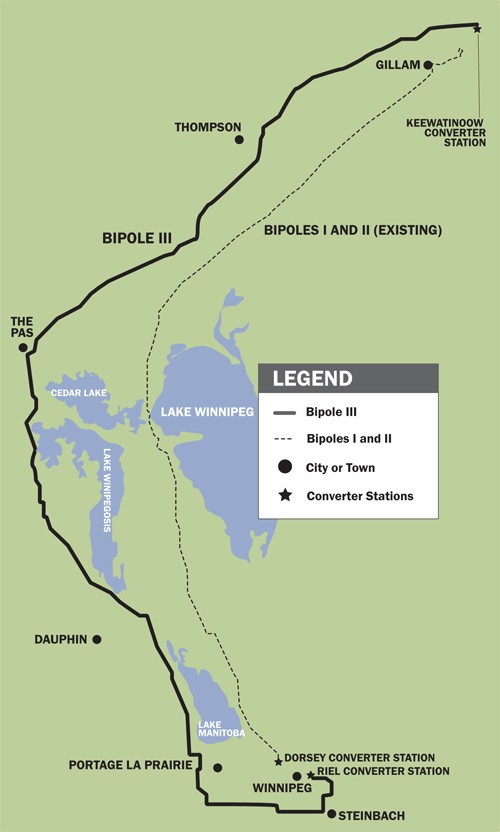West side Hydro line slated at $2.2 billion
Manitoba Hydro given no opportunity to explore alternatives, critics say
Progressive Conservatives, Liberals and other experts continue to accuse the provincial NDP of political interference with the operations of Manitoba Hydro.
The accusations come as Bipole III, a $2.2 billion Hydro transmission line, was confirmed as a project along the west side of Lake Winnipeg, rather than along the east side or under the lake itself.
“For the last 20 years Hydro has planned to build Bipole III along the east side (of Lake Winnipeg),” said Rick Borotsick, PC critic for Manitoba Hydro and MLA for Brandon West.
“The decision to build on the west side is 100 per cent political interference by the Manitoba NDP.”
Bipole III, a transmission line that will stretch from just north of Gillam and curve south all the way down to Winnipeg, is necessary for energy reliability in the province.
Bipoles I and II, which run parallel to one another, are too close together to ensure the preservation of electricity in case of extreme weather or other circumstances.
Bipole III, as a result, requires geographic separation from the other lines and could have been built along the east side of Lake Winnipeg or, as some suggest, even under the lake itself.
However, Hydro recently confirmed a 1,350-kilometre western route, chosen to avoid possible environmental damage to the boreal forest, which the NDP would like named a United Nations Educational, Scientific and Cultural Organization (UNESCO) world heritage site.
“ The decision to build on the west side is 100 per cent political interference by the Manitoba NDP.
Rick Borotsik, PC critic for Manitoba Hydro and MLA for Brandon West
“There were many motivations (in choosing the west side),” said Rosann Wowchuk, Manitoba’s minister responsible for Manitoba Hydro.
The west side route, which the PCs estimate will cost $1.75 billion more than an east side route, was not Manitoba Hydro’s preferred placement of the line, according to Glenn Schneider, manager of public affairs for Manitoba Hydro.
“It’s (Bipole III) been in the planning stages for a number of years and we always expected to build along the east side,” he said. “We haven’t done a comparison of east versus west because we’ve been given (provincial) direction for the west side ... there would be no point in a comparison.”
The PCs, Manitoba Liberals and other critics believe that every angle should be explored when $2.2 billion of taxpayer money is at stake.
“Manitoba Hydro should have been working and researching all the options on this five years ago rather than two years ago,” said Jon Gerrard, leader of the Manitoba Liberal Party.
Gerrard supports the often overlooked underwater alternative, which would involve laying 350 kilometres of special cable beneath Lake Winnipeg.
The costs of a shorter underwater route would be $200 million less than a west side route, with added savings of $250 million in line maintenance over its lifespan, John Ryan, a retired University of Winnipeg geography professor, estimated in a series of Winnipeg Free Press columns published in 2008.
Additionally, the Liberals’ preferred route would avoid environmental damage to the eastern boreal forest, affecting 363 kilometres as compared to 885 kilometres on the east and 812 kilometres along the west. The largely underwater route would also sidestep any issues or cash settlements among First Nations groups and private land owners.
“The cost is lower than the west side line and comparable to the east, without even including settlement or land claims,” Gerrard said.
Wowchuk responded to the underwater proposal by saying that the technology is currently unavailable to build under an inland, freshwater lake.
The technology has only been tested in saltwater bodies, like the North Sea between Norway and Netherlands, which adopted the method for energy transmission.
Wowchuck further finds PC claims of $1.75 billion in savings along the east to be dubious.
She noted the majority of their estimates come from projected savings on a converter station that must be built regardless of where the line is constructed.
“The difference in cost between east and west is $410 million,” she said.
Published in Volume 65, Number 3 of The Uniter (September 16, 2010)








